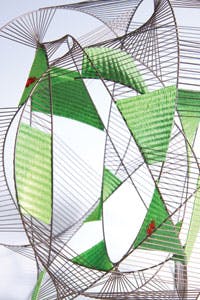Laser welding turns concept into reality
Suffolk, UK - The use of laser welding for jewelry manufacture and repair is becoming a matter of routine rather than the exception, as forward thinking designers and jewelers continue to take advantage of the benefits that the technology brings to the industry.
Away from the mainstream use of lasers for precious metal jewelry manufacture, British artist David Poston continues to draw inspiration from the technology, breaking new ground in the way in which he uses his Rofin StarWeld laser to produce a diverse collection of stunning rings, bracelets and necklaces.
His work is primarily based upon the use of stainless steel and titanium, metals normally associated with the aerospace industry, with only small amounts of precious metals used as embellishment on the finished piece. This choice of materials reflects a desire to provide not only a visually attractive piece, but also a tactile experience, with a wide range of different metals, fabrics, and glass beads used in the production of an item.
The intricate and delicate nature of many of David's designs reflects his depth of knowledge and expertise in the use of the laser for welding and joining. The seemingly limitless capabilities of the laser in his hands provides the inspiration for ever more elaborate and technically challenging designs.
This partnership of craftsmanship and technology is clearly demonstrated in the stainless steel circle bracelet (FIGURE 1), where a combination of 1.0 mm, 0.5 mm, and extremely fine 0.24 mm diameter stainless steel wires are expertly laser joined to produce this elaborate design.
The results of a collaboration with Edinburgh's Dovecot Studios can be seen in a stainless steel and woven tapestry (FIGURE 2), produced from a series of 0.5 mm stainless steel wires, which are laser welded to create a complex 3-D shape. The item is finished with a green woven fabric covering by weaver Jonathan Cleaver, who was responsible for the design and completion of the textile contribution to the piece.
It is in areas such as this that the laser really comes into its own. In the course of completing the woven covering, one of the weld points became detached. With conventional joining processes this would have required considerable re-work to remove the weave and allow re-welding. However, with the laser, the repair was made by just pushing the material slightly to one side to expose the weld position, and the joint was re-made with no damage to the delicate material around the weld area.
The fine and focused precision of the laser is further demonstrated in the range of painted tin bracelets produced by Poston. Manufactured from everyday and often iconic brand packaging (FIGURE 3), these 3-D metal pieces have the appearance of being solid, yet they are produced by seam welding the thin edges of the material using the laser. Even on close inspection, there is no scorching or discoloration on the painted surfaces on either side of the 1.0 mm wide welded seam.
For Poston, as an artist-jeweler, freedom of expression is essential. The inherent flexibility of the laser, combined with his craftsmanship and skill in manipulating both the metal and laser parameters, has allowed him to turn many of his artistic concepts into reality.
For information on this Rofin installation, contact: [email protected]
More Industrial Laser Solutions Archives Issue Articles



